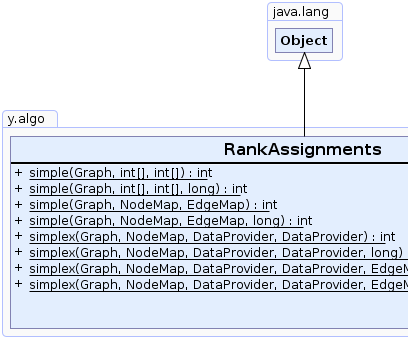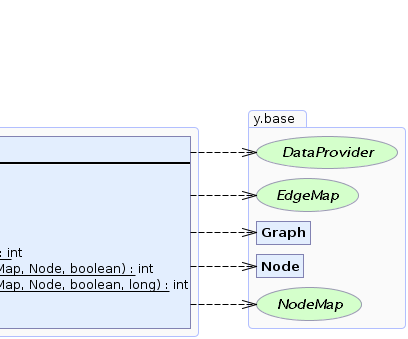 y.algo.RankAssignments
y.algo.RankAssignments
|
Search this API | ||||||||
| PREV CLASS NEXT CLASS | FRAMES NO FRAMES | ||||||||
| SUMMARY: NESTED | FIELD | CONSTR | METHOD | DETAIL: FIELD | CONSTR | METHOD | ||||||||
java.lang.Objecty.algo.RankAssignments
public class RankAssignments
This class provides algorithms for solving the rank assignment problem.
Let G=(V,E) be a directed acyclic graph. Let length(e) denote the minimum length and
weight(e) the weight of an edge e.
The rank assignment problem is the problem of finding integer values
rank(v) for all v in
V, such that:
rank(v) - rank(w) >= length(v,w), for all (v,w) in E and,∑(weight(v,w) * (rank(v) - rank(w))) over all (v,w) in E is
minimized.
 |
 |
| Method Summary | |
|---|---|
static int |
simple(Graph graph,
int[] rank,
int[] minLength)
Like simple(Graph, NodeMap, EdgeMap), but arrays are used instead of NodeMaps
and EdgeMaps. |
static int |
simple(Graph graph,
int[] rank,
int[] minLength,
long maximalDuration)
Like simple(Graph, NodeMap, EdgeMap, long), but arrays are used instead of
NodeMaps and EdgeMaps. |
static int |
simple(Graph graph,
NodeMap rank,
EdgeMap minLength)
This method quickly calculates a tight tree. |
static int |
simple(Graph graph,
NodeMap rank,
EdgeMap minLength,
long maximalDuration)
This method quickly calculates a tight tree given a maximum time duration for the algorithm. |
static int |
simplex(Graph graph,
NodeMap layer,
DataProvider w,
DataProvider minLength)
Solves the rank assignment problem using the simplex method. |
static int |
simplex(Graph graph,
NodeMap layer,
DataProvider w,
DataProvider minLength,
EdgeMap tree,
Node root,
boolean validRanking)
Similar to simplex(Graph, NodeMap, DataProvider, DataProvider) but, additionally,
it is possible to provide a valid initial tree solution for the problem. |
static int |
simplex(Graph graph,
NodeMap layer,
DataProvider w,
DataProvider minLength,
EdgeMap tree,
Node root,
boolean validRanking,
long maximalDuration)
Similar to simplex(Graph, NodeMap, DataProvider, DataProvider) but, additionally,
it is possible to provide a valid initial tree solution for the problem. |
static int |
simplex(Graph graph,
NodeMap layer,
DataProvider w,
DataProvider minLength,
long maximalDuration)
Solves the rank assignment problem using the simplex method given a maximum time duration for the algorithm. |
| Methods inherited from class java.lang.Object |
|---|
clone, equals, finalize, getClass, hashCode, notify, notifyAll, toString, wait, wait, wait |
| Method Detail |
|---|
public static int simplex(Graph graph,
NodeMap layer,
DataProvider w,
DataProvider minLength)
This method assigns a minimum rank to the nodes in a acyclic graph.
Although its time complexity has not been proven polynomial, in practice it takes few iterations and runs quickly.
The algorithm is based on:
Minimum edge length and weights should be non-negative.
graph - the given graphlayer - the NodeMap that will be filled during the execution and returns the zero-based ranking index
for each nodew - the DataProvider that returns an integer value (weight) of each edgeminLength - the DataProvider that returns an integer value (minimum length) of each edge
simplex(Graph, NodeMap, DataProvider, DataProvider, long),
simplex(Graph, NodeMap, DataProvider, DataProvider, EdgeMap, Node, boolean),
simplex(Graph, NodeMap, DataProvider, DataProvider, EdgeMap, Node, boolean, long)
public static int simplex(Graph graph,
NodeMap layer,
DataProvider w,
DataProvider minLength,
long maximalDuration)
This method assigns a minimum rank to the nodes in a acyclic graph.
Although its time complexity has not been proven polynomial, in practice it takes few iterations and runs quickly.
The algorithm is based on:
Minimum edge length and weights should be non-negative.
graph - the given graphlayer - the NodeMap that will be filled during the execution and returns the zero-based ranking index
for each nodew - the DataProvider that returns an integer value (weight) of each edgeminLength - the DataProvider that returns an integer value (minimum length) of each edgemaximalDuration - a preferred time limit for the algorithm (in milliseconds)
simplex(Graph, NodeMap, DataProvider, DataProvider),
simplex(Graph, NodeMap, DataProvider, DataProvider, EdgeMap, Node, boolean),
simplex(Graph, NodeMap, DataProvider, DataProvider, EdgeMap, Node, boolean, long)
public static int simplex(Graph graph,
NodeMap layer,
DataProvider w,
DataProvider minLength,
EdgeMap tree,
Node root,
boolean validRanking)
simplex(Graph, NodeMap, DataProvider, DataProvider) but, additionally,
it is possible to provide a valid initial tree solution for the problem.
Minimum edge length and weights should be non-negative.
graph - the given graphlayer - the NodeMap that will be filled during the execution and returns the zero-based ranking index
for each nodew - the DataProvider that returns an integer value (weight) of each edgeminLength - the DataProvider that returns an integer value (minimum length) of each edgetree - the EdgeMap that returns a boolean value indicating whether or not an edge is a tree edgeroot - the given root node of the tree solutionvalidRanking - true if the argument layer contains a valid ranking,
false otherwise
simplex(Graph, NodeMap, DataProvider, DataProvider),
simplex(Graph, NodeMap, DataProvider, DataProvider, long),
simplex(Graph, NodeMap, DataProvider, DataProvider, EdgeMap, Node, boolean, long)
public static int simplex(Graph graph,
NodeMap layer,
DataProvider w,
DataProvider minLength,
EdgeMap tree,
Node root,
boolean validRanking,
long maximalDuration)
simplex(Graph, NodeMap, DataProvider, DataProvider) but, additionally,
it is possible to provide a valid initial tree solution for the problem.
Minimum edge length and weights should be non-negative.
graph - the given graphlayer - the NodeMap that will be filled during the execution and returns the zero-based ranking index
for each nodew - the DataProvider that returns an integer value (weight) of each edgeminLength - the DataProvider that returns an integer value (minimum length) of each edgetree - the EdgeMap that returns a boolean value indicating whether or not an edge is a tree edgeroot - the given root node of the tree solutionvalidRanking - true if the argument layer contains a valid ranking,
false otherwisemaximalDuration - a preferred time limit for the algorithm (in milliseconds)
simplex(Graph, NodeMap, DataProvider, DataProvider),
simplex(Graph, NodeMap, DataProvider, DataProvider, long),
simplex(Graph, NodeMap, DataProvider, DataProvider, EdgeMap, Node, boolean)
public static int simple(Graph graph,
NodeMap rank,
EdgeMap minLength)
The algorithm is using a highly optimized version of Gansner's algorithm:
Minimum edge length and weights should be non-negative.
graph - the input graph in which all the edges have directions, such that
rank[source] < rank[target] and rank[target] - rank[source] >= minlength[edge]rank - the NodeMap that will be filled during the execution and returns the integer ranking of each
nodeminLength - the EdgeMap that returns an integer value (minimum/tight length) of each edge
simple(Graph, int[], int[]),
simple(Graph, int[], int[], long),
simple(Graph, NodeMap, EdgeMap, long)
public static int simple(Graph graph,
NodeMap rank,
EdgeMap minLength,
long maximalDuration)
The algorithm is using a highly optimized version of Gansner's algorithm:
Minimum edge length and weights should be non-negative.
graph - the input graph in which all the edges have directions, such that
rank[source] < rank[target] and rank[target] - rank[source] >= minlength[edge]rank - the NodeMap that will be filled during the execution and returns the integer ranking of each
nodeminLength - the EdgeMap that returns an integer value (minimum/tight length) of each edgemaximalDuration - a preferred time limit for the algorithm (in milliseconds)simple(Graph, NodeMap, EdgeMap),
simple(Graph, int[], int[]),
simple(Graph, int[], int[], long)
public static int simple(Graph graph,
int[] rank,
int[] minLength)
simple(Graph, NodeMap, EdgeMap), but arrays are used instead of NodeMaps
and EdgeMaps.
The algorithm is using a highly optimized version of Gansner's algorithm:
Minimum edge length and weights should be non-negative.
graph - the input graph in which all the edges have directions, such that
rank[source] < rank[target] and rank[target] - rank[source] >= minlength[edge]rank - an array that will be filled with the ranking r of each node v
such that rank[v.index] == rminLength - an array holding a non-negative value len of each edge e
such that minLength[e.index] == len
simple(Graph, NodeMap, EdgeMap),
simple(Graph, int[], int[], long),
simple(Graph, NodeMap, EdgeMap, long)
public static int simple(Graph graph,
int[] rank,
int[] minLength,
long maximalDuration)
simple(Graph, NodeMap, EdgeMap, long), but arrays are used instead of
NodeMaps and EdgeMaps.
Minimum edge length and weights should be non-negative.
graph - the input graph in which all the edges have directions, such that
rank[source] < rank[target] and rank[target] - rank[source] >= minlength[edge]rank - an array that will be filled with the ranking r of each node v
such that rank[v.index] == rminLength - an array holding a non-negative value len of each edge e
such that minLength[e.index] == len
simple(Graph, NodeMap, EdgeMap),
simple(Graph, int[], int[]),
simple(Graph, NodeMap, EdgeMap, long)
|
© Copyright 2000-2025, yWorks GmbH. All rights reserved. |
||||||||
| PREV CLASS NEXT CLASS | FRAMES NO FRAMES | ||||||||
| SUMMARY: NESTED | FIELD | CONSTR | METHOD | DETAIL: FIELD | CONSTR | METHOD | ||||||||